
Mnesictena is a genus of snout moths in the subfamily Spilomelinae, where it is placed in the tribe Udeini. The genus was erected by the English entomologist Edward Meyrick in 1884. The currently known seven species are exclusively found on New Zealand and the associated Antipodes Islands and Chatham Islands.
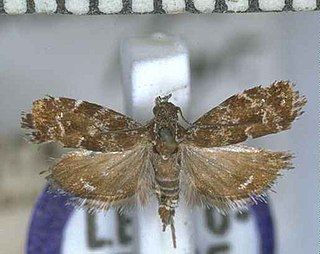
Asterivora analoga is a moth of the family Choreutidae. It is endemic to New Zealand and has been observed in both the North and South Islands. Adults are on the wing in December and January.
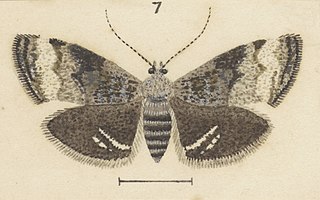
Asterivora albifasciata is a species of moth in the family Choreutidae. It is endemic to New Zealand and has been observed on both the North and South Islands. The adults of this species are on the wing in December and January. Larvae of this species have been raised on Celmisia brevifolia.

Asterivora barbigera is a moth in the family Choreutidae. It is endemic to New Zealand and is found in the southern half of the South Island. It inhabits open mountain sides and adults are on the wing in November to January.

Asterivora colpota is a moth in the family Choreutidae. It was first described by Edward Meyrick in 1911. It is endemic to New Zealand and is found throughout the North and South Islands. It is regarded as a lowland species and adults are on the wing from November until March. This moth has been collected by beating shrubs.

Asterivora fasciata is a species of moth in the family Choreutidae. It is endemic to New Zealand and has been found at Arthur's Pass. The larvae of this species have been reared on Celmisia densiflora and adults are on the wing in January.

Asterivora tillyardi is a species of moth in the family Choreutidae. It is endemic to New Zealand and collected at Aoraki / Mount Cook. Adults of this species are on the wing in March.

Heterocrossa literata is a moth of the Carposinidae family first described by Alfred Philpott in 1930. It is endemic to New Zealand and has been observed the Franz Josef Glacier in subalpine habitat on the West Coast. Adults are on the wing in January.
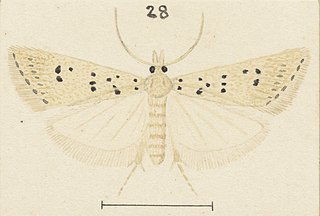
Heterocrossa maculosa is a species of moth in the family Carposinidae. It is endemic to New Zealand and has been found in the southern half of the South Island. Larvae feed on Hoheria angustifolia and Plagianthus regius. Adults are on the wing from November to January. This species is classified as "Data Deficient" by the Department of Conservation.

Amblyptilia epotis is a moth of the family Pterophoridae. It is endemic to New Zealand and is found in the South and Stewart Islands. It inhabits mountainous terrain covered in alpine vegetation or alternatively alpine wetland habitat. The adults of this species are on the wing from February to March. In appearance the adults of this species are variable in colour however this species can be distinguished from similar species by the oblique apical streak on its forewings as well as the patch of white on the costa cilia towards the apex of the forewing.
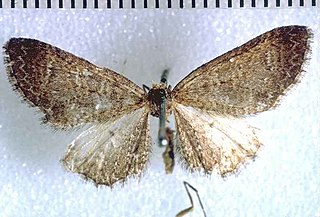
Pasiphila acompsa is a moth in the family Geometridae. It was described by Louis Beethoven Prout in 1927. It is endemic to New Zealand and has been observed in mountainous locations in both the North and South Islands. Larvae of this species have been reared on plants within the Veronica genus. Adults are on the wing from December to February.
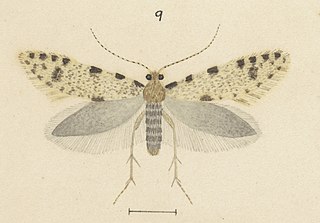
Reductoderces cawthronella is a moth of the Psychidae family. It was described by Alfred Philpott in 1921 and named in honour of the Cawthron Institute. It is endemic to New Zealand and has been collected in Nelson on the Maitai Valley side of the Botanical Hill. The larvae inhabits a fragile, pear shaped case and it has been hypothesised that they are lichen or alga browsers. Larvae pupate at the end of June and adults emerge at the beginning of August until the middle of October.
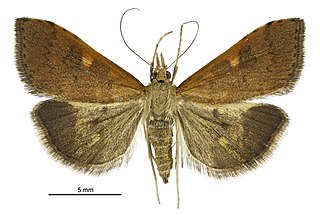
Mnesictena flavidalis is a moth in the family Crambidae. It was described by Edward Doubleday in 1843. It is endemic to New Zealand.

Mnesictena notata is a moth in the family Crambidae. It was described by Arthur Gardiner Butler in 1879. It is endemic to New Zealand.

Asaphodes albalineata is a species of moth in the family Geometridae. It is endemic to New Zealand and has been observed on Stewart Island / Rakiura. This species is similar in appearance to Asaphodes oraria but can be distinguished as it has an unusual pattern on the underside of its hindwings. It inhabits open hill tops and adults are on the wing in December.
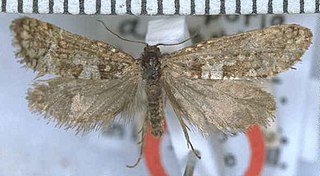
Mallobathra aphrosticha is a moth of the family Psychidae. This species is endemic to New Zealand and has been collected in Fiordland, Otago and Southland. The adults are on the wing in December and the female is semi-apterous.

Tingena crotala is a species of moth in the family Oecophoridae. It is endemic to New Zealand and is found both in the North and South Islands. This species inhabits native forest and is on the wing in November and December.

Tingena hemimochla is a species of moth in the family Oecophoridae. It is endemic to New Zealand and has been observed in the North Island. Adults of this species are on the wing from December until March.
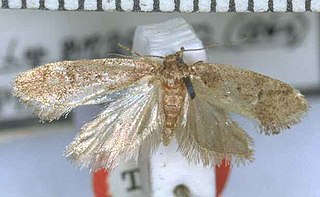
Tingena innotella is a species of moth in the family Oecophoridae. It is endemic to New Zealand and is found in both the North and South Islands. This species inhabits open native forest or scrubland and adults are on the wing from December to March. T. innotella appears to have an affinity for the silver tree fern.
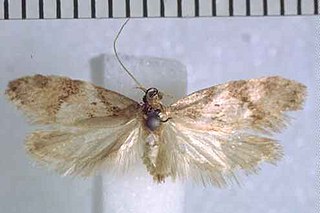
Trachypepla angularis is a species of moth in the family Oecophoridae. It is endemic to New Zealand and has been collected at Lake Rotoroa in the Nelson Lakes National Park in January. This species inhabits mixed native forest.




















